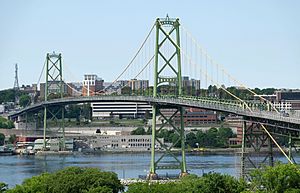Angus L. Macdonald Bridge facts for kids
Quick facts for kids Angus L. Macdonald Bridge |
|
|---|---|

The Macdonald Bridge in July 2015.
|
|
| Coordinates | 44°39′49″N 63°35′05″W / 44.6637°N 63.5846°W |
| Carries | Motor vehicles, pedestrians, and bicycles |
| Crosses | Halifax Harbour |
| Locale | Halifax Regional Municipality (Halifax — Dartmouth) |
| Official name | Angus L. MacDonald Bridge |
| Other name(s) | Macdonald Bridge The Old Bridge |
| Maintained by | Halifax-Dartmouth Bridge Commission |
| MMSI | 16261 |
| Characteristics | |
| Design | Suspension bridge |
| Total length | 1.3 kilometres (0.81 mi) |
| Width | 11.5 metres (34.8 feet) |
| Height | 102.9 metres (337.69 feet) |
| Longest span | 441 metres |
| Clearance above | 54 metres (177.25 ft) at centre-span |
| Clearance below | 46.9 metres (153.87 ft) at centre-span |
| History | |
| Designer | Philip Louis Pratley Henry Hugh Lewis Pratley Charles Nicholas Monsarrat |
| Construction begin | 1952 |
| Opened | April 2, 1955 |
| Statistics | |
| Daily traffic | 44,000 (2012) |
| Toll | CA$1.00 cash/$0.80 MACPASS |
The Angus L. Macdonald Bridge is a cool suspension bridge that crosses Halifax Harbour in Nova Scotia, Canada. It opened a long time ago, on April 2, 1955. This bridge is one of two big bridges that connect the Halifax Peninsula to Dartmouth in the Halifax Regional Municipality.
It's named after Angus Lewis Macdonald, who was a leader (called a premier) of Nova Scotia. He passed away in 1954, but he was very important in making sure this bridge got built. The bridge was designed by Philip Louis Pratley, a famous Canadian bridge designer. He also designed the Lions Gate Bridge in Vancouver, and you might notice they look a bit alike, especially their towers!
The Macdonald Bridge gets very busy, especially during rush hour. Because it's close to downtown Halifax and Dartmouth, it can get crowded. Big trucks aren't allowed on this bridge; they have to use the wider MacKay Bridge instead. But regular cars, bikes, and people walking can use it. Public buses also cross, connecting different parts of the city. In 2014 and 2015, over a million vehicles crossed the bridge each month!
To cross the bridge, you usually pay a small fee, called a toll. In 2015, it was $1.00 if you paid with cash, or $0.80 if you used a special electronic system called MACPASS. When the bridge first opened in 1955, the toll was 40 cents for a car, plus 5 cents for each person inside.
Contents
Building the Bridge
Construction of the bridge happened between 1952 and 1955. Workers used special underwater structures called caissons to build the parts of the bridge that are in the water. Sadly, five workers lost their lives during the construction. The bridge officially opened on April 2, 1955, and it cost about $11.5 million to build back then.
Making the Bridge Better: Modernization Projects
The Macdonald Bridge has been updated a few times to keep it strong and useful.
1999 Updates
In the late 1990s, the bridge got a big makeover. Before, it had two lanes for cars and one path for walking and utilities. After the update, it had three lanes for cars. The middle lane could change direction to help traffic flow better during busy times.
To make the bridge lighter, old asphalt and concrete were removed. Special steel plates, called an orthotropic deck, were used instead. This new deck was 35% lighter! New paths for people walking and biking were added to the outside of the bridge.
Lights were also added to the bridge towers, making them glow from sunset until midnight. Some people thought this was a waste of electricity, especially because Halifax Harbour is often foggy.
The "Big Lift" Project (2015-2017)
Starting in 2015, the bridge went through another huge renovation project called the "Big Lift." This project cost about $150 million. Almost every piece of steel that makes up the main hanging part of the bridge was replaced, except for the towers and the two main cables. The parts of the bridge that aren't hanging (the approach spans) stayed the same.
This was a very complex job! It was only the second time in the world that a suspension bridge had its main hanging sections completely replaced while still allowing traffic to cross during the day. Most of the work happened at night, but sometimes the bridge had to close for entire weekends. The main replacement part of the project finished in February 2017.
During the "Big Lift," buses still crossed the bridge when it was open. When the bridge was closed, special shuttle buses used the MacKay Bridge instead. For people who walked or biked, Halifax Harbour Bridges offered a free shuttle service 24 hours a day, so they could still cross the harbour.


